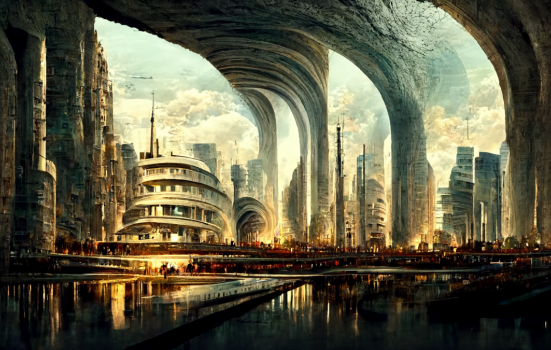Artists are increasingly concerned that generative AI is stealing their copyright. Lawyers Patrick Wheeler and Zoë Deckker consider whether existing law provides creators adequate protection against the rise of AI-generated artworks.

Kent Madsen
Copyright is a property right which recognises an artist’s creativity and originality. It covers a variety of original material, including artistic, literary, dramatic, musical or artistic works. A copyright owner has the exclusive right to copying, renting, lending, performing, exhibiting and adapting the work. Carrying out any of these acts without the copyright owner’s permission amounts to a primary act of copyright infringement.
How does generative AI create art?
Generative AI is trained on, or ‘learns’ from, vast quantities of material scraped from the internet and then generates new content. The visual material can include images, videos and 3D models. AI image generators are proving hugely popular. They produce images when prompted by a user’s command, such as: "Create an image of a modern-day celebrity in the style of Botticelli." The results have received widespread coverage with artists growing increasingly concerned about a technology which ignores their rights and their creativity.
Examples of generative AI art include Stable Diffusion, described as “a latent text-to-image diffusion model capable of generating photo-realistic images given any text input [that] empowers billions of people to create stunning art within seconds”. It was launched in 2022 by Stability AI and is trained on the data set LAION (Large-scale Artificial Intelligence Open Network), which claims to be a non-profit organisation making machine learning resources available to the public.
Other text-to-image generators include Midjourney and DreamUp, a text-to image generator established by the art-focused social media platform DeviantArt.
What are the copyright issues?
Issues arise when the content used to train AI systems is protected by copyright. If a database contains copyright-protected works by artists and those artists are unaware of, and have therefore not consented to, the use of their works in training an image generator, the artist has lost effective control over the use of their works. This is a major issue - as yet unresolved - so it's not surprising that objections to such unauthorised use are being pursued legally both in the US and in the UK.
In January 2023, cartoonist Sarah Andersen, artist and illustrator Kelly McKernan and concept artist Karla Ortiz filed a lawsuit in California against UK-based Stability AI Ltd and Stability AI Inc, Midjourney Inc and DeviantArt Inc in the US. The artists described these generators as “21st-century collage tools that violate the rights of millions of artists”. They argued that Stability AI acquired billions of copyrighted images without permission and created compressed files without the consent of, or providing compensation to, the artists.
In response, the three companies filed a motion to dismiss the lawsuit, to which the artists in turn filed a legal objection. At a hearing in July, the judge said that although he was inclined to dismiss most of the lawsuit, he would not strike out the entirety of the claim. Shortly after, stock image provider, Getty Images, filed an application in the London High Court for an injunction preventing Stability AI from selling its AI image-generated system in Britain. The application claimed Stability AI’s use of its images to train its system amounted to a breach of copyright and that the infringement has been integral to the success of Stability AI's business.
Stability AI is facing a further claim in the US by Getty, in which it is being accused of using of over 12 million copyright-protected images without permission. Stability AI has applied to dismiss the motion.
What will happen?
The outcome of these cases will give some indication as to how the clash between generative AI and copyright protection might be resolved in future. Although US decisions are not binding in the UK, they may provide persuasive precedent, especially as the legal area is a new one, meaning binding precedent may not be available.
It could be argued that the process of selecting and formulating a text prompt to be fed into an image generator is a creative act itself, which should result in copyright protection being conferred both on the instructions and on the artistic output. But that's separate from the question of whether, in creating the artistic output, the image-generation programme has reproduced a substantial part of existing copyright works, which would constitute an act of infringement.
How else are artists protected?
In the meantime, organisations are lobbying for greater protections for the creators of artworks which have been subsumed into image generators. The European Guild of Artificial Intelligence Regulation aims to create legislation and regulation to “protect copyright holders and artists from predatory AI companies”. It has been created to extend the work of the Concept Art Association of America into the EU.
Technological tools are being developed to provide greater protection for artists. Ben Zhao, Professor of Computer Science at the University of Chicago, has created a free software tool, Glaze, which he describes as “a system designed to protect human artists by disrupting style mimicry”. Glaze works by understanding the AI models that are being trained on human art and uses machine learning algorithms to produce a set of minimal changes to artworks. The artworks appear unchanged to human eyes but look like a dramatically different art style to AI models.
The use of generative AI, and the associated issues, are fast evolving. There will be pressure on the legal framework to keep up with the challenges posed by advancements in technology, and to balance innovation with copyright protection. Assuming at least one of the cases in the US or the UK proceeds to a judgment, the approach taken by the courts will be of great interest in the continuing debate.
Patrick Wheeler is Head of IP and Data Protection at Collyer Bristow.
Zoë Deckker trained as a solicitor at Collyer Bristow.
![]() collyerbristow.com/
collyerbristow.com/
![]() @Collyer_Bristow
@Collyer_Bristow





